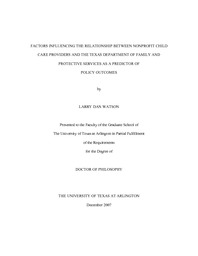
ATTENTION: The works hosted here are being migrated to a new repository that will consolidate resources, improve discoverability, and better show UTA's research impact on the global community. We will update authors as the migration progresses. Please see MavMatrix for more information.
Show simple item record
| dc.contributor.author | Watson, Larry Dan | en_US |
| dc.date.accessioned | 2008-04-22T02:41:16Z | |
| dc.date.available | 2008-04-22T02:41:16Z | |
| dc.date.issued | 2008-04-22T02:41:16Z | |
| dc.date.submitted | December 2007 | en_US |
| dc.identifier.other | DISS-1991 | en_US |
| dc.identifier.uri | http://hdl.handle.net/10106/777 | |
| dc.description.abstract | Over the past 30 plus years, there has been a shift in public administration responsibilities from providing direct services to the complex functions of contract management. Public administrators must now perform functions across jurisdictional lines to accomplish the purposes of the state (Frederickson & Smith, 2003). Public administrators can no longer be concerned only with the functions of government but must accomplish their work through the private and nonprofit sectors as well. The movement from the provision of direct services to the management of contracts is evident in Texas, where state legislators are working to privatize the state's child welfare services. More than ever, the Texas Department of Family and Protective Services (TDFPS) must rely on a network of mostly nonprofit child care contractors to provide services to children in the conservatorship of the state of Texas. This study tested the proposition that the relationships between the state agency funder and the contract provider would be characterized by the administrator of the contract agency either as supplementary, complementary, or adversarial (Young, 1998) depending on 1) child care provider agency characteristics, 2) child care provider agency financial characteristics, 3) child care provider agency administrator demographics, 4) child care provider agency administrator's opinion on the role of government, and 5) child care provider agency administrator's views on management. The study also tested the proposition that the relationship between the state agency and the contract provider has an influence on the provider agency's achievement of the policy goals of the state, as evidenced by their level of compliance with state minimum standards for child care. The study found that structural elements including: 1) child care provider agency characteristics, 2) child care provider agency financial characteristics, 3) child care provider agency administrator demographics, 4) child care provider agency administrator's opinion on the role of government, and 5) child care provider agency administrator's views on management were not predictors of the agency's relationship with TDFPS, and the relationship was not a predictor of policy outcomes. The study finds that the social context, or the relationship, is more important than the structural factors. Implications for practice and theory development are discussed. | en_US |
| dc.description.sponsorship | Rodriguez, Alejandro | en_US |
| dc.language.iso | EN | en_US |
| dc.publisher | Public Administration | en_US |
| dc.title | Factors Influencing The Relationship Between Nonprofit Child Care Providers And The Texas Department Of Family And Protective Services As A Predictor Of Policy Outcomes | en_US |
| dc.type | Ph.D. | en_US |
| dc.contributor.committeeChair | Rodriguez, Alejandro | en_US |
| dc.degree.department | Public Administration | en_US |
| dc.degree.discipline | Public Administration | en_US |
| dc.degree.grantor | University of Texas at Arlington | en_US |
| dc.degree.level | doctoral | en_US |
| dc.degree.name | Ph.D. | en_US |
| dc.identifier.externalLink | https://www.uta.edu/ra/real/editprofile.php?onlyview=1&pid=1141 | |
| dc.identifier.externalLinkDescription | Link to Research Profiles | |
Files in this item
- Name:
- umi-uta-1991.pdf
- Size:
- 775.7Kb
- Format:
- PDF
This item appears in the following Collection(s)
Show simple item record


